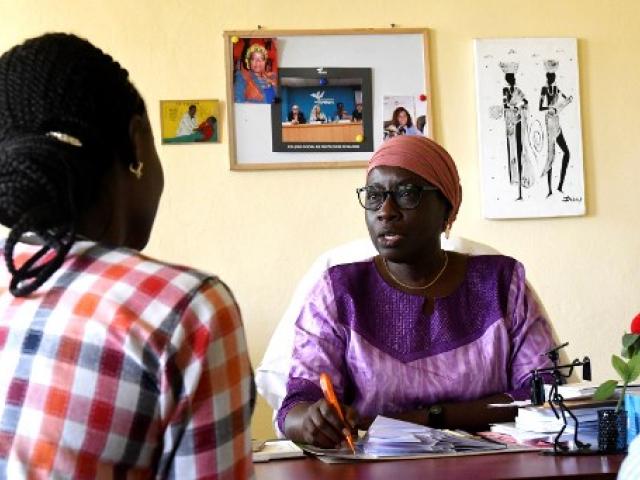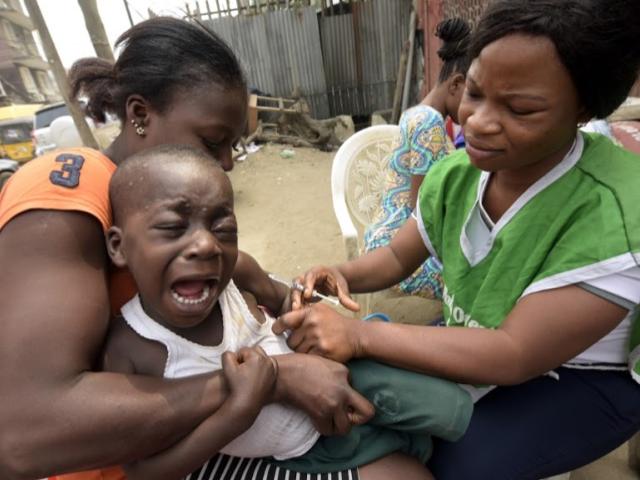In December 2023, president Bola Tinubu put pen to paper on a far-reaching plan to overhaul Nigeria’s health sector.
The Nigeria Health Sector Renewal Investment Initiative will focus on major overhauls and spending as Africa’s largest and most populous economy aims to achieve universal health coverage by 2030.
Under the plan, Nigeria will spend more than US$1 billion over three years to build stronger health systems — a “turning point” according to World Health Organization (WHO) chief Tedros Ghebreyesus.
Key aspects include upgrading physical infrastructure and equipment, retraining frontline health workers, and revamping the Basic Health Care Provision Fund to improve access to essential services.
The WHO, Gavi, the Global Fund and the Bill and Melinda Gates Foundation are among the partners supporting the initiative.
The aim of the investment is to help Nigerians get better and stay better. In this factsheet, we track progress on key health indicators in Nigeria over the past five years. Our previous factsheet, published in 2018, kept pace with these indicators over the preceding 10 years.
We have grouped these indicators into three themes: infant and child health, reproductive health and women's health.
Our data came from the following sources:
- The 2011, 2017 and 2021 editions of the Multiple Indicator Cluster Surveys (or ‘Mics’) conducted by Unicef, the UN agency for children
- The 2018 Nigeria Demographic and Health Survey (DHS)
- The National Nutrition and Health Survey (NNHS)
- The Nigeria HIV/AIDS Indicator and Impact Survey (NAIIS)
The Trends in maternal mortality for 2000 to 2020 from WHO
Infant and child health
Child health indicators are a key measure of a country's health system, as they reflect children's access to health services.
1. Infant mortality rate — reduced to 63 deaths per 1,000 live births
The infant mortality rate is the probability that a child will die before reaching the age of one. It is expressed as the number of deaths per 1,000 live births.
This rate has been falling steadily in Nigeria. In 2007, the infant mortality rate was 86 deaths per 1,000 live births, according to the Mics survey.
In the 2016/17 Mics survey, the rate was estimated at 70 deaths per 1,000 live births.
The most recent Mics survey is from 2021 and was published at the end of 2022. It was conducted by Unicef and the National Bureau of Statistics (NBS) from September to December 2021. Some 38,806 women aged 15-49 were interviewed in 41,532 households across the country.
The survey estimated Nigeria's infant mortality rate at 63 deaths per 1,000 live births.
Data from the Nigeria Demographic and Health Survey also supports this downward trend. The DHS is conducted every five years.
- The 2018 demographic health survey has the most recent national data. It found that Nigeria’s infant mortality rate was 67 deaths per 1,000 live births in 2018.
- The 2013 survey reported this at 69 deaths per 1,000 live births.
- The 2008 survey reported a rate of 75 deaths per 1,000 live births.
Reducing infant mortality
According to the WHO, breastfeeding is an effective way to protect a child's health and survival, thereby reducing child mortality.
“This is why mothers need to be encouraged to breastfeed exclusively for the first six months,” Dr Muhammed Adeboye, a consultant paediatrician at the University of Ilorin Teaching Hospital in Nigeria, told Africa Check.
For working mothers, Adeboye said the Nigerian government should encourage organisations to adopt a breastfeeding policy. Education and family support are critical factors in women's exclusive breastfeeding practices, says the WHO.
2. Under-five mortality rate — reduced to 102 deaths per 1,000 live births
Under-five mortality is the risk of a child dying before the age of five. It is expressed per 1,000 live births.
The latest estimate, from MICS 2021, puts Nigeria’s under-five mortality rate at 102 deaths per 1,000 live births.
In 2011 the rate was 158 deaths per 1,000 live births, an increase from 138 deaths per 1,000 live births in 2007.
The country saw a significant decrease in 2016/17, when the rate was 120 deaths per 1,000 live births.
The latest estimate is in line with findings from the 2018 Nigeria Demographic and Health Survey which put the rate at 132 deaths per 1,000 live births.
Previous demographic and health surveys estimated the rate at 157 deaths per 1,000 live births in 2008 and 128 deaths per 100,000 live births in 2013.
Food quality is a major factor
The WHO's Nutrition and Food Safety (NFS) unit told Africa Check that nutrition-related factors contribute to the deaths of children under five.
These include maternal nutrition and environmental pathogens that interfere with nutrient absorption. Poor complementary feeding - the provision of inadequate or inappropriate types and amounts of solid or semi-solid foods in addition to breastfeeding - also contributes to deaths.
The nutrition unit said a number of children under two would live past their fifth birthday if they were properly breastfed.
3. Nutrition
A child’s nutritional status reflects their overall health. Children are considered well nourished when they are well cared for, have access to adequate food and are not exposed to recurrent illnesses.
The first round of Mics in 2007 reported that 25% of children under five were moderately underweight, 34% were moderately stunted, and 11% were moderately wasted.
In 2011, 24% of children under five were moderately underweight, 36% of children under five were moderately stunted, and 10% of children under five were moderately wasted.
Malnutrition is not covered in the 2016/17 survey and the latest edition, the 2021 survey. Biola Arosanyin, a senior statistician at the national statistics bureau, told Africa Check that the team did not record anthropometry - or body measurements - in the Mics 2021 survey because of Covid-19.
“Anthropometry is the measurement of body parts that we use to calculate the indicators you have listed,” she said.
Meanwhile, results from Nigeria's latest demographic health survey show that 37% of children under five are stunted, 7% are wasted and 22% are underweight.
Acute malnutrition at alert levels
The latest edition of the 2018 National Nutrition and Health Survey (NNHS) provides data on under-five malnutrition rates. This shows that acute malnutrition levels have remained at the alert levels of 5 to 9.9% for the years since 2014.
The alert level or warning level is a critical stage when action must be taken quickly to prevent deaths. One of the many measures that should be implemented is to improve nutrition in the first 1,000 days of a child's life.
The prevalence of underweight in children aged 0-59 months was 19.9%, stunting was 32% and the prevalence of overweight remained below the 7% threshold.
Prof Tanimola Akande, a public health expert, says malnutrition in children under one year of age is not uncommon, especially with poor complementary feeding.
Reproductive health
4. Maternal mortality rate — 512 maternal deaths per 100,000 live births (2018)
Maternal mortality refers to deaths due to complications from pregnancy or childbirth or within 42 days after the end of pregnancy.
It is expressed as the number of maternal deaths per 100,000 live births in a given period.
The latest Mics survey still does not provide an estimate of the maternal mortality ratio in the country.
Dr Isaika Olanrewaju, a former director of household statistics at the NBS previously told us the sample size (of women) was not large enough to conduct a survey.
The 2018 Nigeria Demographic Health Survey estimated the rate at 512 maternal deaths per 100,000 live births.
The 2013 survey found 576 deaths per 100,000 live births, a rise from 545 deaths per 100,000 live births as per the 2007 survey.
What WHO data shows
The WHO’s trends in maternal mortality report for 2000 to 2020 provides estimates of Nigeria's maternal mortality ratio.
The report showed that in 2020 Nigeria had a maternal mortality rate of 1,047 deaths per 100,000 live births. This estimate was based on sources such as civil registration and vital statistics systems, population-based household surveys and specialised studies.
Aligning with SDG target
With the above estimates, Nigeria is far from achieving the Sustainable Development Goal of reducing the global maternal mortality ratio to less than 70 per 100,000 live births.
However, Dr Jumoke Ogunro, a consultant obstetrician and gynaecologist at the Alpha Assisted Reproductive Klinic (ARK) in Lagos says the SDG target on maternal mortality can be met if the basics are done right.
The first step, she said, was to strengthen efforts to educate pregnant mothers.
“If these women are properly educated, they can quickly seek help if something goes wrong healthwise,” she told Africa Check.
The next thing would be to improve living standards so that people have access to quality healthcare. “Our hospitals should have good facilities and our healthcare professionals must be skilled to be able to manage complications during childbirth. Health insurance policies for pregnant women is another area we must pay attention to.”
5. Adolescent birth rate — reduced to about 75 births per 1,000 adolescent women
The adolescent birth rate is defined as the annual number of births to females aged 10-14 or 15-19 years per 1,000 females.
However, only 15-19 year olds are included in the available data.
Based on interviews with 36,176 women aged 15 to 49, the latest Mics survey estimated the adolescent birth rate for young women aged 15 to 19 to be 75 births per 1,000 adolescent women.
The 2016/17 survey estimated it at 120 births per 1,000 adolescent females while the 2011 survey estimated it at 89 births per 1,000 adolescent females.
The Nigeria Demographic and Health Survey puts the figure at a higher 106 births per 1,000 adolescent females.
The overall trend is still one of decline. Previous rounds of the demographic survey estimated 123 births per 1,000 females in 2008 and 122 births per 1,000 adolescent females in 2013.
What informs the high adolescent birth rates?
Dr Kayode Adebayo is a medical director and consultant obstetrician and gynaecologist in Lagos State. He told Africa Check that religious and cultural beliefs encourage adolescent births in some parts of the country.
“For example, some regions still practise an act that when a girl child sees her first menstruation, that same time the next month she should be in her husband's house, so you can now imagine the age of a child at her first menstruation,” Adebayo said.
6. Contraceptive prevalence rate — increased to 21.7%
The contraceptive prevalence rate is the percentage of women of reproductive age (15-49 years) using any method of contraception at a given time.
The rate was 14.7% in 2007, rising to 17.5% in 2011, before falling to 13.4% in 2016/17. It jumped to 21.7% in 2021.
With the level of awareness about contraception, one would expect the rate to be 40 or 50%, but issues such as cultural and religious practices are a hindering factor, Dr Baba Madu, who heads the national accounts department at the statistics office, told Africa Check.
“Contraception is still disregarded in some parts of Nigeria,” he said.
In the 2018 round of the Demographic Health Survey, the contraceptive prevalence rate for any method among married women was estimated to be 17%.
Modern contraceptive use is higher among sexually active unmarried women (28%) than among currently married women (12%).
Previous demographic and health surveys estimated the rate at 14.6% in 2008 and 15.1% in 2013.
7. Marriage before age 18 — Slight reduction in child marriage figures
Marriage before the age of 18 is a violation of human rights, but remains a reality for many children, according to the Mics survey.
The first round of the survey in 2007 shows that 15% of women aged 15-49 had been married before the age of 15, while 40% of women aged 20-49 had been married before the age of 18.
In 2011, 18% of women were married before the age of 15, while 40% of women were married before the age of 18.
In the 2016/17 Mics survey, an estimated 18.5% of women aged 15 to 49 reported being married or in a union by the age of 15. Among women aged 20-49, around 44% were married or in a union for the first time before the age of 18.
The latest round of the Mics estimated that 12.5% of women aged 15-49 reported being married before the age of 15. Among women aged 20-49, about 34% were married or in a union before the age of 18.
‘A lot to work to eliminate child marriage’
One of the global targets in the Sustainable Development Goals is to end child marriage by 2030.
Human rights lawyer Ajibike Arokoyo-Babalola told Africa Check that Nigeria had a lot of work to do to get there.
“To make matters worse, the Marriage Act 1990, which should have been a haven and reference point for the rejection of underage marriage, under its Article 11 (1) (b), states the age of marriage to be 21, but that those younger than 21 can get married where ‘consent’ is gotten,” she said.
“The question is consent from whom? Does it mean that a parent can wake up one day and just decide to give a child away as it’s their consent that’s needed? It is noteworthy that no cap has been placed on the age limit within which this so-called consent can be given, meaning consent can be given, even with respect to underaged children.”
8. Condom use and HIV/Aids
The Joint United Nations Programme on HIV/Aids (UNAids) is a global body that is working to end Aids as a public health threat by 2030.
According to UNAids, HIV prevalence in Nigeria was estimated to be 1.3% in 2021, with about 1.9 million people living with the virus. The country ranked fourth among countries most affected by HIV in 2020.
The latest round of the Mics survey doesn’t capture HIV-related estimates among women. But the 2016/17 survey shows that only 34.8% of Nigerian women aged 15 to 49 had been tested for HIV and knew their status. This was up from just 11.4% in 2011 and 12.6% in 2007.
The 2016/17 survey also estimated that only 29.3% of women aged 15 to 24 knew how to avoid HIV infection. This was higher than estimates from the 2011 and 2007 surveys, which were 22.5% and 19.4% respectively.
The proportion of women using a condom during sex with multiple partners increased from 33.3% to 41.3% in the latest round of the Mics survey.
The proportion of men using a condom during sex with multiple partners increased from 35.3% to 38.5% in the latest round of the Mics survey.
More data is available
The latest round of the Nigeria HIV/AIDS Indicator and Impact Survey was published in 2018.
It is a cross-sectional survey that assesses the prevalence of key HIV-related health indicators.
According to the survey, only 17.3% of married women who had sex with a non-marital, non-cohabiting partner in the last 12 months reported using a condom the last time.
Among women who had given birth in the 12 months prior to the survey, 41.5% reported knowing their HIV status.
Women’s mental health
9. Domestic violence — increased to 31%
According to the World Health Organization, domestic violence is the most common form of violence against women. It affects their mental health and puts them at risk of developing depression, anxiety and other mental health problems.
The 2018 demographic health survey provides the most recent national data on the proportion of women of reproductive age (15-49 years) who have experienced violence.
Thirty one per cent of women reported experiencing physical violence and 9% sexual violence. Six per cent of women reported experiencing physical violence during pregnancy.
More than half (55%) of women who have experienced physical or sexual violence have never sought help to stop the violence. This is the highest recorded by the survey so far.
The 2013 survey estimated that 28% of women aged 15-49 had experienced physical violence at least once since the age of 15, and 7% had experienced sexual violence at least once in their lifetime.
Forty-five per cent of women who experienced violence never sought help or told anyone about the violence.
In 2008, 28% of women surveyed said they had experienced physical violence since the age of 15. Seven per cent of women said they had experienced sexual violence at some point in their lives.
Forty-five per cent of women did not seek help from any source and did not tell anyone about the violence.
10. Consent — reduced to 29.3%
According to the second Mics survey of 2011, 46% of Nigerian women (aged 15-49) felt that their husband or partner was justified in hitting them for at least one reason.
Twenty-nine per cent of women thought that beatings were justified if they neglected their children, while 26% thought they should be beaten for going out without telling their husbands.
According to the 2016/17 Mics survey, an estimated 33.7% of women aged 15-49 believed that a husband was justified in hitting or beating his wife if she went out without telling him, or if she burned the food.
The latest round of Mics estimated that the percentage of women who say that a husband is justified in hitting or beating his wife for one reason or another is 29.3%. Fortunately, the number has been falling over the years.






Add new comment